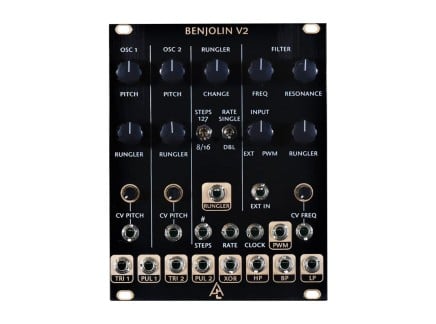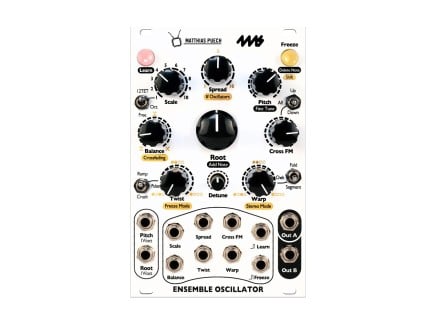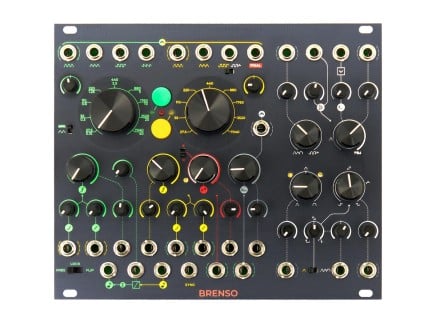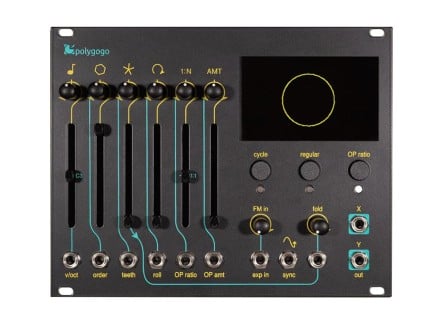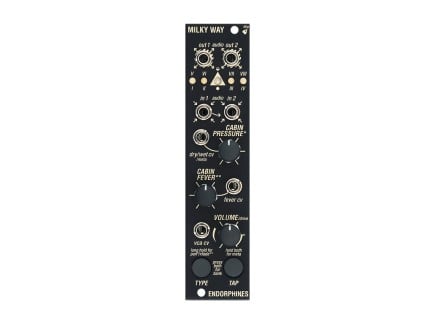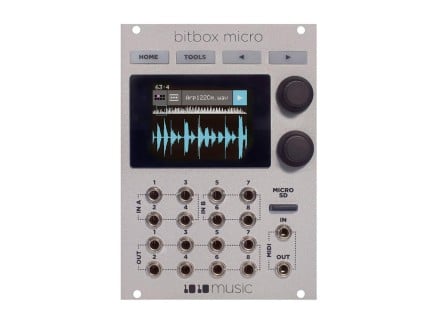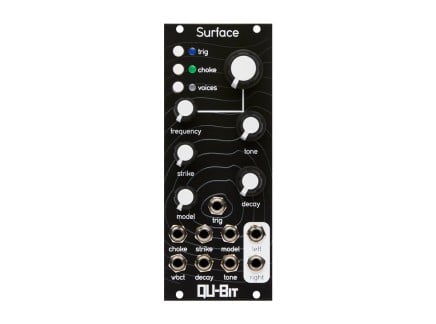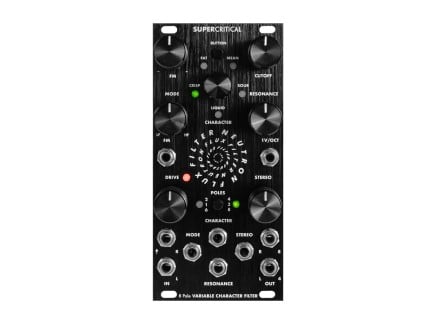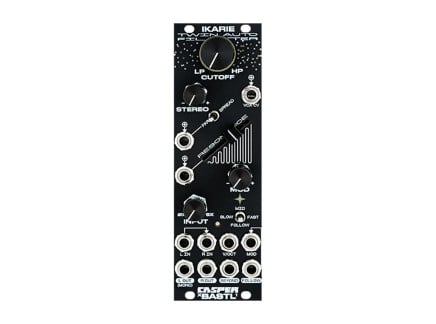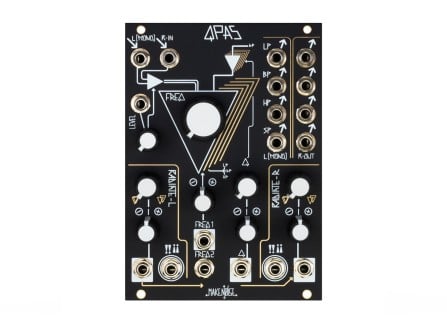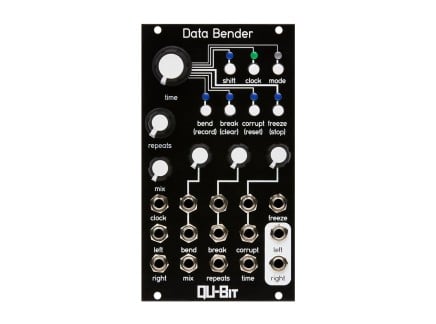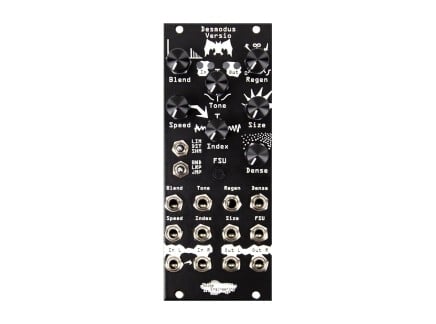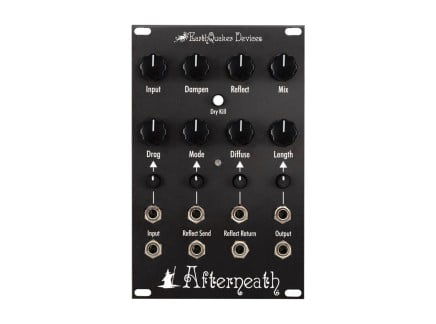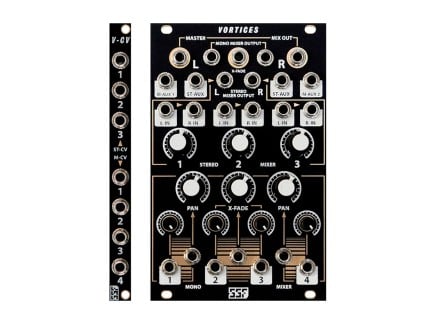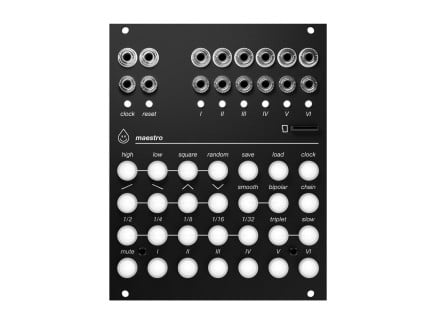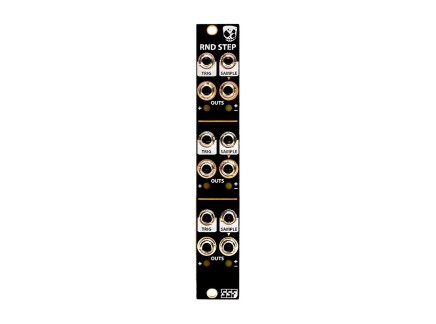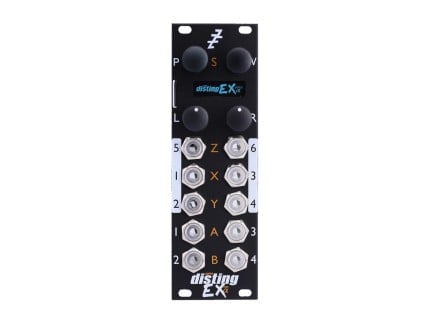2020 has seen the release of a stunning range of Eurorack modules from a stunning range of designers. It's difficult to narrow in on our favorites: from the digital designs of Noise Engineering and Qu-Bit Electronix to deep analog explorations by Frap Tools and Mutable Instruments all the way to Expert Sleepers's endless utility, we've seen a tremendous amount of creativity emerge this year. So while this list definitely isn't exhaustive, let's take a look at twenty of our favorite modules to be announced/released this year.
Best Eurorack Oscillators
From new approaches to polyphony and revisitations of classic complex oscillators, chaotic synth voices, classic physical modeling techniques, and more, Eurorack gained a huge number of interesting sound sources this year. Far from typical bread-and-butter oscillators, these devices all stand out and provide their own singular, fascinating approaches to music and sound design.
The 4ms Ensemble Oscillator is a polyphonic oscillator that brings together complex chords and complex waveshapes. It starts with sixteen sine wave oscillators and uses a combination of additive, FM, wave folding, and phase distortion synthesis methods to create intricate sounds, and the Ensemble Oscillator quantizes the pitches of these oscillators to a selectable scale or harmonic series. Users set the root note of the base oscillator and then spread the sixteen oscillators throughout their chosen note pool. Instead of the traditional stair-stepping between notes as heard on most quantizers, the Ensemble Oscillator crossfades between notes, smoothly transitioning from one to another. The 30 factory preset scales range from traditional 12-tet circle-of-fifths scales to just ratio scales, as well as Bohlen-Pierce and Wendy Carlos' Alpha and Beta scales. However, users may also enter their own custom scales, opening the possibilities beyond the included scales. The waveshaping circuits each feature three adjustable modes that take on their own character and add different kinds of harmonic interest. The Ensemble Oscillator offers a unique take on synthesis methods, both in terms of tuning and timbre. It combines several different types of sound-shaping methods with internal quantization that stretch beyond traditional tuning concepts, which offers a diverse palette of opportunities.
We've seen a lot of digital oscillator modules come out recently, further pushing the envelope of sound design in Eurorack. Polygogo offers a new and unique approach to sound generation in the form of what E-RM calls stereo polygonal synthesis. The module features a highly vivid OLED screen that displays the shapes being sonified, offering unique insight into how all the parameters are ultimately shaping the waveforms being generated. Aside from parameters like Teeth and Fold, which apply various shaping and wavefolding adjustments to the audio, Polygogo also contains an FM operator, adding another layer of digital sheen to the sounds being generated. There's a wide range of sounds waiting to be discovered in Polygogo, from smooth, glassy drones to degraded, chaotic noise.
The mighty Benjolin is back with version two from After Later Audio. This module is an instrument in its own right, a complex, chaotic source of unpredictability that rewards exploration and experimentation. The secret is the rungler: a shift register-based source of chaotic stepped modulation. Hordijk describes it as a "stepped havoc wave," falling in the spectrum of waveshapes between pure sine and pure noise, although more skewed towards the noise side of things. The two oscillators provide the clock and data information for the shift register, which in turn modulates the two oscillators, and these oscillators also modulate each other in a feedback loop. They do not track 1V/oct, so if you're looking for that, look elsewhere. The two oscillators' triangle waveforms pass into a comparator to create a pulse wave with variable width. This runs into the multi-mode filter, which in turn has its own rungler CV input and simultaneous outputs of low pass, band pass, and high pass filtering. After Later Audio added several improvements from the original design, including an external audio input for the filter, an external rungler clock input, and support for Music Thing Modular's Turing Machine expanders. The Benjolin is full of unexpected behavior wherein the slightest turn of a knob sends the module flying off in a radically different direction. It has a peculiar sound, a bubbly, gurgling sound that shifts and morphs as it evolves. Get lost for hours with this esoteric instrument that is full of surprises.
Dreadbox unveiled the latest members of their Chromatic series of Eurorack modules, including the Antidote, a resonator and voice based upon Karplus-Strong synthesis techniques. The interesting thing about Antidote is that unlike most implementations of this type of synthesis, which occur in the digital realm, Antidote is fully analog through its use of a bucket-brigade delay (BBD) chip. Most of us tend to think of chorus, flangers, and delays when we hear about BBD-based devices, and thanks to its external input Antidote can still be used for these purposes, but Dreadbox has adapted this decades-old technology to include accurate pitch tracking across five-octaves. In combination with a triggered internal noise source and filters, Antidote can be a flexible and affordable option for anyone looking for a different flavor of voice in their modular system. Combine this with their other recently release module, the 8-stage OTA phaser Euphoria for some wicked and murky textures.
Buchla's classic 259 Complex Wave Generator became an inspiration for quite a few Eurorack-format oscillator modules—all offering a new take on the design. Frap Tools's Brenso joins the family of complex oscillators, and it has a lot to offer both in terms of the well-thought out feature set, and the overall sonic possibilities. The module's wide set of parameters are organized into four clearly laid out sections—green and yellow for the two triangle-core oscillators, white for waveshaping, and red for amplitude and ring modulation. The module features dedicated buttons for locking the pitch settings of both oscillators, so you don't need to worry about accidentally bumping the frequency knob mid-live set.
Brenso also allows you to apply linear thru-zero and exponential FM simultaneously with independent control over the amount of each. The waveshaping section is very comprehensive, and includes a pluckable wavefolder with a non-linear decay which renders the opportunity for this module to be used almost as a complete voice. The modulation bus is quite extensive, however fear not of being lost as the inputs and attenuators are coded to match the colors of the sections they are designed to control. While there may be many complex oscillators in Eurorack format to choose from these days, Frap Tools's unique take on the design has a lot to offer and it certainly can't be missed.
Best Drum / Percussion Modules
Of course, oscillators are far from the only way to make sound in a Eurorack system. These days, people's modular systems are often centered around exploring alternative means of sound production, from physical modeling to sampling and beyond. This year saw the release of several interesting modules geared toward percussion, sampling, and more.
Among the newest entries into the world of physical modeling modules in Eurorack, Surface by Qu-Bit Electronix is a straightforward approach to add an assortment of plucked strings and percussive sounds to your sonic toolbox. Despite having just one input for V/Oct pitch control, Surface offers up to eight notes of polyphony—subsequent triggers on sounds with long decay times will rotate through the available voices, making it easy to set up strummed guitar-like patches. Other sounds found in Surface include models of electric and prepared pianos, vibraphones, tablas, and even synthesized kick and snare sounds. For further patching fun, Surface offers stereo outputs, and several different modes for spatialization of its internal voices. With its ease of use and variety of compelling sounds, Surface is a conceptually accessible way to dive headfirst into the world of physical modeling, and would make a fine addition to the racks of veteran patchers as well.
The Queen of Pentacles is Endorphin.es's modular re-imagining of the classic Roland TR-909...so if you're looking for heavy-hitting kicks and punch snares, this is the module for you. With a full seven channels of drum synthesis under the hood, the Queen of Pentacles is a sure-fire source for getting a groove going. There are dedicated analog bass drum, snare drum, and clap channels, as well as four sample-based channels, typically used for closed hats, open hats, ride, and cymbal—though of course, these can be substituted with whatever sounds you desire. Much in the style of their previous drum modules BLCK_NOIR, the Queen of Pentacles also offers built-in DSP and a DJ-style combo low/highpass filter, great for giving your sound some space and shaping your overall spectral content. With clockable rolls on each channel, individual and mixed outputs, and a host of performance features that make live manipulation a breeze, the Queen of Pentacles is one of the finest all-in-one Eurorack drum modules to date.
1010 Music introduced a welcome revision to their much-loved Bitbox, with the Bitbox Mk2 and Bitbox Micro. With double the processing power of the first-generation Bitbox, Mk2 provides Eurorack users an excellent all-in-one solution for sampling and managing playback of pre-recorded audio—be it loops or one-shots. Each of the Bitbox Mk2's 16 "pads" can be configured to operate in one of several modes: one-shot playback, granular synthesis, sample slicing, synced clips, multisamples, or live recording. Its touch-screen interface makes navigation and interaction easy, and its support for MIDI and CV/Gate inputs means that you can interact with the Bitbox in basically any way you desire. With built-in delay and reverb and a range of features far too deep to explore here, the Bitbox is the ultimate Eurorack multi-voice sampler. And of course, for anyone who doesn't need all of the power of the full-size Bitbox Mk2, its little sibling, the Bitbox Micro, provides a powerful subset of the same features—but allowing only eight "pads," and with somewhat scaled-down I/O.
Best Eurorack Filters
Of course, filters are one of the most characteristic parts of any synthesizer—and choosing a filter for your system can help to solidify a sonic identity for your music. Filters have been around for ages, sure—but amazingly, forward-thinking designers continue to push the boundaries of what a filter can do, and how you can interact with it. Let's take a look at some of the more interesting filters to come out this year.
The Neutron Flux is like your favorite buffet restaurant. It’s got all of those classic & creamy filters that remind us of warm analog flavors, as well as some interesting options that you might not have shown up for, but hey it's right there, why not give it a try—you might find a new favorite. Supercritical’s new filter module boasts five flavors of "character" from Moog-like ladders and Oberheim OTAs to sour acid filters and beyond, like one character setting just called "Mean" that’s full of distortion and unpredictable response curves. The Neutron Flux can also operate in a variety of pole settings, from 1–8 pole in fact, with stereo and mono settings unlocking even more variety in the multiple character settings. Supercritical have served up a serious spread of possibilities with the Neutron Flux, and they’re not done with it by any means, promising updates with additional new features in the near future.
Blades is the most recent multimode filter created by the renowned brand Mutable Instruments, and it's no secret in the world of Eurorack that when Émilie Gillet designs a module we are in for something special.
Actually, Blades is two filters under a single panel that can be used completely independently, or intertwined for stereo and serial processing. The filters in blades are resonant and can be easily pushed into self oscillation, which makes them great for both adding the controlled squeals to the sounds, and being used as sound generators all by themselves. Blades is also pingable, and as such it can be quickly adapted as a rhythmic percussion module. Unique to the module are the continuously morphable filter modes, and routing. If that wasn't enough for a good filter, the input stage on Blades features an overdrive circuit that can vary from soft-clipping to two-stage wavefolding. With all of this in place it is evidently clear that whether you already have a filter or two in your setup or just looking for your first Eurorack filter, MI Blades is a great addition to any system.
And of course, we'd be remiss to exclude one of our favorite new filter modules, Bastl's Ikarie. Inspired by the classic Czech science fiction epic of the same name, the Ikarie Stereo Filter landed this year and proved once again that Bastl and Casperelectronics are some of the most creative and kooky designers this side of the Milky Way. The Ikarie flexes an impressive feature set for an 8HP module, sporting a dual filter core design that seamlessly morphs from high to low pass and allows stereo or twin-peak filtering, an envelope follower, built-in VCA, panning, and input gain that can boost an external signal or add a satisfying overdrive. Ikarie’s unique architecture allows for a variety of interesting patching and experimentation, from hijacking the filter cores to get aggressive 24dB filtering, using the VCA for ring-modulation type effects, or utilizing the panning features to blend oscillator waves. From liquid resonance sweeps to pinged percussion, lush stereo processing and formant filtering, the Ikarie does it all and delivers an extremely satisfying user experience. If you’re in need of a fun and playable filter that both inspires and sounds phenomenal, be sure to check out this stellar module.
Best Eurorack Effects
With the continued expansion of accessibility of DSP, digital synthesis and effects have become a ripe area for exploration in Eurorack. This year, we witnessed the release of tons of digital effects modules—from dedicated glitch processors to expansive reverbs, delays, and more.
Data Bender from Qu-Bit Electronix is a circuit-bent digital audio buffer that mimics the ways in which audio equipment fails. The sound of skipping CDs, failing tape machines, and software errors are all accessible under voltage control. The surprisingly high quality 24-bit 96kHz audio buffer holds up to a minute of stereo audio for glitching and mangling. Use the internal clock to set the sampling rate, or introduce an external clock with divisions and multiplications for synced glitchiness. Divide the audio buffer into smaller sections of repeating audio using the Repeats knob. Drop out, decimate, or destroy your sounds using the corrupt function for a range of different ways to mess up and reinvent your sounds. Bend and manipulate the characteristics of a malfunctioning tape player or use the break function to capture the spirit of damaged or corrupted digital audio. Freeze the audio currently in the buffer and add non-destructive mangling to the audio buffer. The Data Bender takes aspects of audio that users otherwise would try to avoid and harnesses them into a fun and exciting module.
Adapted from Earthquaker Devices's highly-acclaimed guitar pedal, the Afterneath reverb welcomely entered the world of Eurorack this year. The modular version retains the sound and controls of its pedal-form predecessor, yet taking advantage of the new format it features modulation points for the crucial parameters and thus opens up opportunity for more dynamic interaction with the sound.
Afterneath has a very wide range of sonic possibilities ranging from bright shimmers to dark otherworldly textures. Reflect send and return I/O opens up the possibilities to use the module in the pseudo-stereo mode, and to inject more processing into the feedback path. The module is capable of self-oscillating, and can act as an excellent drone maker by itself. The panel also features a "Dry Kill" button which completely removes the dry signal from the output upon pressing—very handy for quickly adding drama in live performances. With such a comprehensive set of features, and wide sonic palette Afterneath is surely one of the best reverbs in Eurorack format that you can find.
This year, Electrosmith released their Daisy platform for DSP programming, and we've already seen some incredible instruments come out which utilize its power to the fullest (including the aforementioned Surface and Data Bender from Qu-Bit). Desmodus Versio is everything you'd expect from a Noise Engineering reverb—untamed, gritty, and aggressive are its specialties, but that's not to say that it can't be dialed back for typical reverb duties with the added benefit of control voltage capabilities. It also offers fully stereo inputs and outputs, a welcome addition to an ever-growing world of spatially inclined Eurorack systems. Perhaps the best feature of DV is that because it utilizes the Daisy at its core, Noise Engineering has promised to offer alternative Versio firmwares that give new functionality to the same hardware. We've already seen the multi-tap delay Imitor Versio, and more are certainly on the way. While multi-functional modules and alternate firmwares are not new to Eurorack modules, we're still pleased to see another option for getting the most out of a single module.
With ECR-1, Tasty Chips bring the powerful world of convolution reverb to Eurorack. For those unfamiliar, convolution reverb is a DSP technique which allows us to capture and recreate the properties of physical (and not) environments. This is accomplished by recording the sound of a short simple impulse sent into the desired space. The resulting waveform is called an impulse response, and the internet is full of free and paid libraries. ECR-1 allows you to both create impulse response files, and run sounds through them without leaving the comfort of your Eurorack system, and of course you can load IRs samples acquired elsewhere on the included flash drive. This means that you can have an endless amount of reverb tones within a single module. But there is more…
The thing is that since impulse responses are merely samples, pretty much anything can be used as a source, and thus ECR-1 really rewards experimentation. You can use the sounds of guitar amps, your favorite pedals and modules, or field recordings—all have potential to add novel flavor to your sound. Oh, and did we mention that you can load multiple IR files into the ECR-1 and crossfade between them manually or using control voltage?
Best Eurorack Mixers + Utilities
No Eurorack system is complete without utilities—they tie together all of the core parts of your system and allow for musical refinement. From mixers and general-purpose utilities, there was no shortage of new nuts-and-bolts modules this year.
With the recent resurgence of old analog consoles, four-track cassette players, and reel-to-reel tape decks among all kinds of music makers, we've slowly started to see more and more Eurorack modules borrowing inspiration in both sound and workflow from these antiquated machines. Not many modules have been so explicitly informed by the dynamic response and potential overdriven sounds of those old devices as Vortices, the latest mixer from Steady State Fate. Even without the saturation aspects, it's a thoroughly capable mixing solution for any Eurorack system, with four mono inputs, three stereo inputs, and potential for voltage controlled panning, crossfading, and feedback patching through its auxiliary inputs.
On top of this, all of the main channel inputs boast plenty of gain and compression/limiting circuits to impart character onto any incoming signal. Add in the 2hp expander for CV control over channel levels, and you have one of the most flexible and compelling mixing solutions available in 18hp.
The Cosmotronic Cosmix is an eight-channel mixer with a few bells and whistles that make it an indispensable addition to your rack. It's a powerful mixer with four mono channels, two stereo, an aux send, and a unique master drive section make for a flexible and straightforward mixing setup, the channels can be muted, panned, and sent to the aux channel pre or post fader, everything you'd find on your typical desktop mixer, but in a compact 16HP. The drive section of the Cosmix is an interesting spatial-maximizer, which in short, allows you to dial in character from a light saturation to a crunchy drive in stunning stereo. While mixers and utilities can sometimes be not the most exciting of modules, they're often some of the most important pieces of the most exciting patches; here in our showroom, it's used daily to glue together example patches and jams on the shop cases thanks to its intuitive and quick workflow.
Acid Rain’s Maestro is a modulation game changer. Inspired by automation lanes in DAWs, and laid out to be ergonomically used one-handed, the Maestro leads to exciting performance oriented patching effortlessly. Designed with the intention of being a lightning fast and intuitive way to perform with modulation both simple and complex, the Maestro features six tracks of clocked uni/bipolar modulation that can be easily assigned, muted, divided or multiplied, chained, and saved with the press of a button. The simplicity and ease of use of the Maestro cannot be understated, it offers a wealth of possibilities in a very approachable and well thought-out interface that makes using it inspiring and enormously fun.
The Disting has long been a popular choice for Eurorack systems across the world, offering more versatility and useful functions in each iteration of its design. So when Expert Sleepers announced the new Super Disting EX Plus Alpha earlier this year, it was immediately clear that this was the most substantial update to the Disting line yet. At first glance, the Disting EX looks just like two normal Distings sharing a panel and screen. Indeed, it can run two simultaneous algorithms from its predecessors at once, from quantizers to random voltage generators, and even audio sources like oscillators and sample-players. But Disting EX doesn't stop there, offering several Super modes to take advantage of the extended I/O and processing power, such as a stereo tape-inspired delay and looper, eight-voice polyphonic sampler, and as a WAV recorder. Much like the other Expert Sleepers modules, Disting EX is compatible with an abundance of expansion options, and additionally can be used with the growing i2c ecosystem, with modules and controllers such as those made by Michigan Synth Works. Disting EX is a shining example which showcases the incredible promise for the future of digital designs in Eurorack.
Last but certainly not least, RND Step is a three-channel sample and hold module, made in a collaboration between Steady State Fate and famed modular Youtuber Ben "DivKid" Wilson. It offers six random voltages to supply clocked stochastic modulation to your Eurorack system. Each channel features a pair of linked sample and hold outputs, one unipolar, one bipolar, and two internal pink noise generators as the sample sources. Every time it receives a clock signal, it produces a new random value at both outputs. The bipolar output from each channel may also sample external CV or audio signals with a +/-10V range. Channel one's trigger input is normalled to the other channels, letting users clock all six outputs from a single input trigger. It accepts slow triggers with minimal voltage droop or clocked well into the audio range for pseudo-bit crushing of external audio signals. The internal pink noise sources clocked at audio rates are great for hi-hats and snares. This is DivKid's third collaborative module, following up on the performative Mutes designed with Befaco and the much loved øchd organic drifting LFO made in partnership with Instruo. RND Step is a compact modulation source and a perfect way to spice up your patches with randomness.
Of course, there's a lot that we couldn't talk about here. 2020 brought us an absolutely incredible range of new modules and devices. Xaoc's new Sarajewo syncable BBD delay, IME's Kermit MkIII, new designer Modbap's Per4mer, and ADDAC's 403 VC Time Signature Clock Sources, for instance, all immediately come to mind as outstanding and exciting new additions to the Eurorack ecosystem. And of course, Eurorack-peripheral devices like Make Noise's 0-CTRL and Intellijel's new Palette 104 cases gave us new options for how to play and how to house our systems. Now many years into the resurgence of modular synthesizers, we're excited to say that Eurorack is still growing, and somehow, brilliant and creative minds are still coming up with exciting and inspiring new ways to conceptualize sound and music.


